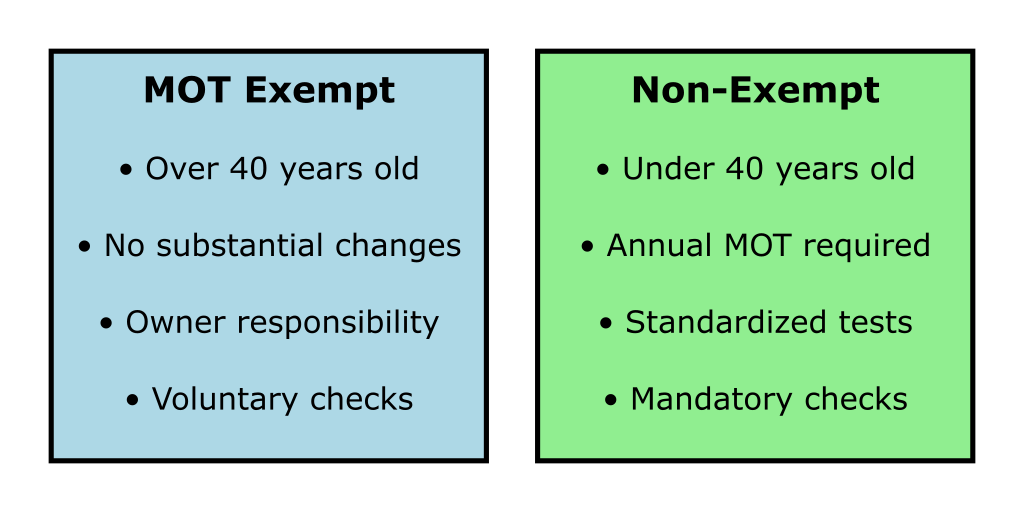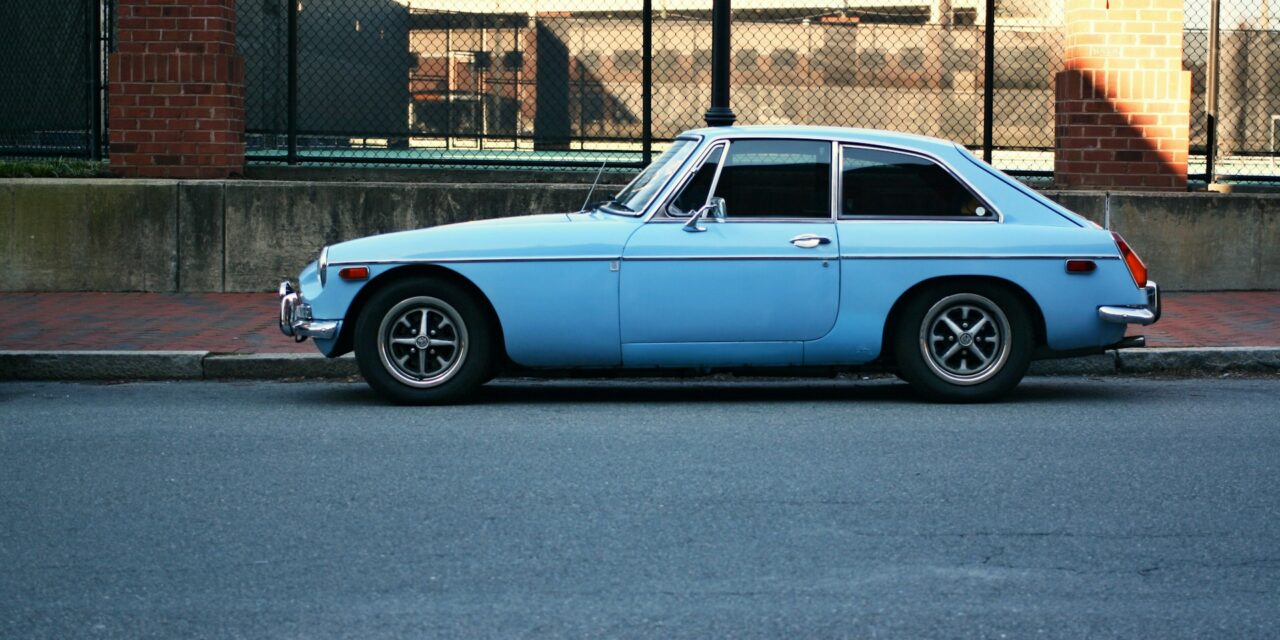Did you know that over 1.5 million classic cars in the UK are MOT exempt? This exemption often sparks curiosity and debates among car enthusiasts and everyday drivers alike. Understanding why old cars are MOT exempt involves diving into history, regulations, and the unique charm of vintage vehicles. In this comprehensive guide, we’ll explore the reasons behind this exemption, its implications for owners, and how it impacts road safety.
Key Takeaways on Why Old Cars Are MOT Exempt
- Age Requirement: Vehicles over 40 years old are generally MOT exempt.
- Owner Responsibility: Classic car owners must maintain roadworthiness despite exemption.
- Historical Preservation: The exemption aims to preserve automotive heritage.
- Limited Road Use: Many classic cars are driven infrequently, reducing safety risks.
- Enthusiast Consideration: The exemption supports the classic car hobby and community.
- Regular Checks: Self-inspections and voluntary testing are crucial for exempt vehicles.
- Modification Impact: Substantial changes can affect a vehicle’s exemption status.
Understanding MOT Exemption for Old Cars
The 40-Year Rule: Why Old Cars Become MOT Exempt
The primary reason why old cars are MOT exempt is the 40-year rule. This regulation states that vehicles manufactured or first registered more than 40 years ago can qualify for exemption from the annual MOT test. For example, in 2023, cars made before 1 January 1983 do not need an MOT test.

This rolling 40-year exemption means that each year, a new batch of vehicles becomes eligible for exemption. It’s important to note that the exemption applies from the date of first registration, not the date of manufacture. This distinction can be crucial for cars that were registered significantly later than their production date.
Vehicle of Historic Interest (VHI) Declaration
To understand why old cars are MOT exempt, it’s crucial to know about the Vehicle of Historic Interest (VHI) declaration. Owners must declare their vehicle as a VHI to qualify for exemption. This process confirms that the car has not undergone substantial alterations in the past 30 years, preserving its historical integrity.
The VHI declaration process involves:
- Confirming the vehicle’s age
- Verifying that no substantial changes have been made
- Declaring the vehicle’s status when taxing it
This declaration is typically made when renewing the vehicle tax, either online or at a Post Office. It’s a legal requirement, and false declarations can lead to penalties.
Reasons Behind MOT Exemption for Old Cars
1. Preserving Automotive Heritage
One of the main reasons why old cars are MOT exempt is to support the preservation of automotive history. The exemption encourages enthusiasts to maintain these classic vehicles, keeping a piece of motoring heritage alive on UK roads.
Classic cars represent different eras of automotive design and technology. By exempting them from standard MOT tests, which may not be suitable for their unique characteristics, the government acknowledges their historical value. This exemption allows owners to maintain their vehicles in a way that respects their original design and functionality.
2. Owner Expertise and Responsibility
Many classic car owners are passionate about their vehicles and possess extensive knowledge about their maintenance. The MOT exemption for old cars acknowledges this expertise, trusting owners to keep their vehicles in excellent condition without mandatory annual testing.
Classic car enthusiasts often:
- Have in-depth knowledge of their vehicle’s mechanics
- Perform regular maintenance and repairs themselves
- Belong to car clubs that share expertise and best practices
- Invest significant time and resources in vehicle upkeep
This level of dedication and expertise is a key factor in why old cars are MOT exempt. The government recognizes that these owners are likely to maintain their vehicles to a high standard voluntarily.
3. Limited Road Use
Most classic cars see limited road use compared to modern vehicles. This reduced time on the road is another factor in why old cars are MOT exempt, as it minimizes their impact on overall road safety.
Statistics show that classic cars typically:
- Travel fewer than 1,000 miles per year
- Are often used primarily for shows and events
- Are rarely used as daily drivers
This limited use means that these vehicles are less likely to develop the wear and tear associated with regular, everyday driving. Consequently, the risk they pose to road safety is considered lower than that of more frequently used modern vehicles.
4. Unique Maintenance Needs
Classic cars often have unique maintenance requirements that differ from modern vehicles. The MOT exemption for old cars allows owners to focus on specialized care tailored to their vehicle’s specific needs rather than adhering to standardized testing procedures.
For example:
- Older braking systems may require different maintenance approaches
- Carbureted engines need different tuning compared to modern fuel injection systems
- Vintage electrical systems may not be compatible with standard MOT testing equipment
By exempting these vehicles from standard MOT tests, the government acknowledges that a one-size-fits-all approach to vehicle testing may not be appropriate for classic cars.
The MOT Exemption Process for Old Cars
Understanding why old cars are MOT exempt is just the first step. It’s equally important to know how the exemption process works:
- Age Verification: Confirm that your vehicle was manufactured or first registered more than 40 years ago.
- VHI Declaration: When taxing your vehicle, declare it as a Vehicle of Historic Interest.
- Substantial Change Check: Ensure your vehicle hasn’t undergone substantial changes in the last 30 years. This includes major alterations to the chassis, engine, or axles.
- V112 Form: If not taxing the vehicle, you may need to complete a V112 form to declare exemption.
- Record Keeping: Maintain records of any work done on the vehicle, which can be useful if the vehicle’s exempt status is ever questioned.
Safety Considerations for MOT Exempt Old Cars
While understanding why old cars are MOT exempt is important, safety remains paramount. Owners of exempt vehicles must ensure their cars are roadworthy at all times. Regular self-inspections and voluntary MOT tests are recommended to maintain safety standards.
Key Areas to Check in MOT Exempt Old Cars:
- Brakes: Ensure the braking system is functioning correctly, including the handbrake.
- Tires: Check for adequate tread depth and proper inflation.
- Lights: Verify all lights are working, including indicators and brake lights.
- Suspension: Look for signs of wear or damage in suspension components.
- Steering: Ensure the steering is responsive and there’s no excessive play.
- Body and Structure: Check for rust or damage that could compromise the vehicle’s integrity.
- Exhaust System: Verify the exhaust is secure and not excessively noisy or smoky.
- Windscreen and Wipers: Ensure clear visibility and functioning wipers.
Benefits of Voluntary Testing
Even though old cars are MOT exempt, many owners choose to have voluntary tests done. These tests can:
- Provide peace of mind about the vehicle’s condition
- Identify potential issues before they become serious problems
- Offer documentation of the car’s condition, which can be valuable for insurance purposes
- Help maintain the value of the classic car
The Impact of Modifications on MOT Exemption
It’s crucial to note that substantial modifications can affect why old cars are MOT exempt. If a classic vehicle has undergone significant changes to its chassis, engine, or other major components, it may lose its exemption status and require regular MOT testing.
What Constitutes a Substantial Change?
The Department for Transport provides guidelines on what is considered a substantial change:
- Chassis: Replacements of the chassis with a new or reconditioned chassis of a different pattern
- Axles and Running Gear: Alterations that change the wheelbase or track of the vehicle
- Engine: Changing the engine to one that’s not of the same number of cylinders or that’s from a different manufacturer
- Bodywork: Major changes to the body, such as changing a two-door car to a four-door model
Non-Substantial Changes
Some modifications are not considered substantial and do not affect the MOT exemption:
- Changes made to preserve a vehicle, such as replacing old components with new ones of the same pattern
- Safety improvements, like adding seatbelts or improving lighting
- Changes that use components from other classic vehicles of the same type
The Role of Classic Car Insurance
While exploring why old cars are MOT exempt, it’s important to consider insurance implications. Many insurers offer specialized classic car policies that take into account:
- The unique value of classic vehicles
- Limited mileage use
- The expertise of owners in maintaining their vehicles
These policies often require that the vehicle is kept in good condition, which aligns with the responsibility that comes with MOT exemption.
Future of MOT Exemption for Classic Cars
As automotive technology evolves, there’s ongoing debate about the future of MOT exemption for classic cars. Some key considerations include:
- Environmental concerns and emissions standards
- Advancements in vehicle safety technology
- The increasing rarity and value of classic vehicles
Owners and enthusiasts should stay informed about potential changes to legislation that might affect why old cars are MOT exempt in the future.
Conclusion: Balancing Heritage and Safety

Understanding why old cars are MOT exempt involves recognizing the balance between preserving automotive history and ensuring road safety. While the exemption offers benefits to classic car owners, it comes with the responsibility of maintaining these vehicles to high safety standards.
For classic car enthusiasts and owners, the MOT exemption represents trust in their dedication to their vehicles. However, it’s essential to remember that exemption doesn’t mean neglect. Regular maintenance, voluntary checks, and a commitment to safety ensure that these beautiful pieces of history can continue to grace our roads for years to come.
By embracing both the privilege and responsibility of owning an MOT exempt classic car, enthusiasts play a crucial role in keeping automotive heritage alive while ensuring the safety of all road users. The exemption is not just about reducing bureaucracy; it’s about recognizing the unique place these vehicles hold in our cultural and technological history.
As we look to the future, the reasons why old cars are MOT exempt may evolve, but the passion for preserving these rolling pieces of history is likely to remain strong. Whether you’re a classic car owner, an enthusiast, or simply curious about automotive regulations, understanding the MOT exemption for old cars provides valuable insight into how we value and maintain our motoring heritage.





